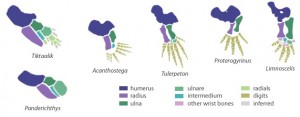How many fingers do you have? Hopefully, 5. Do you think that’s the normal condition for all animals? Do you think that’s air you’re breathing right now? … OK, so I watched the Matrix last night, but still, do you think all tetrapods (dudes with 4 feet, including you, and anything else with four flippers, wings, or feet) have 5 digits on each limb? Actually, there’s a pattern within tetrapods of limb reduction in various lineages – our earliest ancestors seemed to experiment with digit numbers and went a bit berserk by growing extra fingers from their fishy flippers.
Progressive Palaeontology, Leeds 2013
Progressive Palaeontology (ProgPal) is an annual event where early career researchers get to demonstrate their research to an equivalent audience in a reasonably informal atmosphere. It’s also renowned as a mega p*ss-up, as everyone knows palaeontologists are chronic alcoholics (hence the dinosaurs with feathers hypothesis). This year, it was in the vibrant and cosmopolitan northern UK city of Leeds. Some of the research communicated there was pretty freaking sweet. You can find recordings of all of the talks on Palaeocast (at some point in the future), and the Twitter feed was #progpal if you want to see a historical live version of the event.
Conservation biology – let’s get integrated!
Conserving our world’s biodiversity is currently one of the biggest challenges we face. I wrote a post recently about some of the issues palaeontologists face when trying to make our science relative to current conservation management and biodiversity issues (and have written elsewhere about this too). This is very much a developing issue within which palaeontology is framing itself, as with ever squeezing science budgets around the world, scientists are being forced to find the hook or application that makes their research ‘relevant’ to broader society. The role that palaeontology can play for both climate change and biodiversity patterns and processes is the natural progression of science accompanying such shifts.
Social Media for Science Outreach – A Case Study: That social media thang
This was initially posted at: http://www.nature.com/spoton/2013/04/social-media-for-science-outreach-a-case-study-that-social-media-thang/ as part of a series of case studies exploring how academics use social media.
Jon began university life as a geologist, following this with a treacherous leap into the life sciences with a course in biodiversity and taxonomy. Now undertaking a PhD in tetrapod biodiversity and extinction at Imperial College London, there was a brief interlude were Jon was sucked into the world of science policy and communication. He blogs at https://blogs.egu.eu/network/palaeoblog/, tweets as Protohedgehog and co-runs an [infamous, probably] podcast series called Palaeocast. Jon can usually be found procrastinating in pubs, trying to exchange bad science, usually about dinosaurs, in exchange for food and beer.
Tell us a bit about you and your social media project
I’m currently a PhD student at Imperial College London, investigating the biodiversity patterns of tetrapods (anything with four limbs/wings/flippers) about 145 million years ago to see what we can figure out in a macroevolutionary sense, and whether we can find a ‘hidden’ mass extinction in the fossil record. I commit some of my time to 3 major social media platforms: blogging, tweeting, and podcasting, with a bit of Facebook, LinkedIn, Google+ and others on the side. These activities are less of a project, per se, and more just stuff I do in parallel, and often with overlap, with my PhD research.

